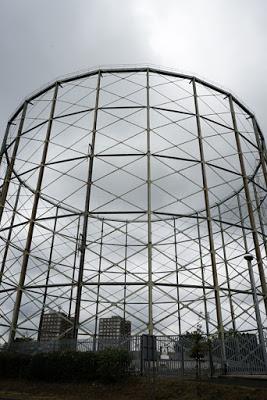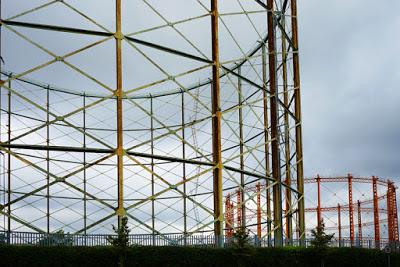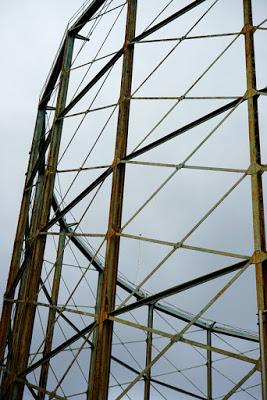
The gasholder (or gasometer) stored gas. As the tank (lift) filled with gas, it would rise up within its metal frame, with water at the base providing a tight seal. When demand exceeded supply, gas would be taken from the holder, which would descend again as it emptied. However, as town gas is no longer manufactured in local gasworks, and supplies of natural gas depend upon new pipeline technology, these huge storage tanks are no longer required.
Why is Old Kent Road's so significant? The listing text explains that it was the largest gasholder in the world when engineer George Livesey built it in 1879-1881. It was also an important engineering innovation, using the latest techniques to create something entirely new which served as a model for future constructions. Its unusually thin wrought iron and pioneering use of mild steel were used in a structure which 'treated the guide-frame as a cylindrical lattice shell for the first time, the gasholder had to be built up tier-by-tier since it relied on the complete circle for integrity'. This would be a source of inspiration for helical structures by future engineers.

Inside this frame, the tank was the deepest constructed at the time. It would remain one of the deepest ever built. Even the appearance of the gasholder was radical. No decoration was applied, a departure from earlier gasholder designs (and indeed Victorian industrial architecture generally). The new design was drastically cheaper than earlier constructions - and no doubt its lack of ornament helped cut costs further!
Livesey was the obvious choice to build the gasholder, and not only because of his engineering talent. It was part of the South Metropolitan Gas Company's gasworks; the company chairman was his father Thomas. Livesey was Company Secretary and would himself become chairman in 1885.

Among his acts of philanthropy was founding Camberwell Public Library No. 1 (later the Livesey Children's Museum and now closed), just across the road from the gasworks. He would also develop a scheme which allowed a gas meter, lighting and cooker to be installed in a customer's home without payment. The cost of the installation would be recovered through subsequent payments. This made gas lighting and cooking accessible to working class families.

Gasholders are now an increasingly threatened part of our industrial heritage. Obsolete, they pose challenges for reuse: the ground on which they stand is often heavily polluted. However, they are also valued as historically significant local landmarks. There was outcry when demolition of Gasholder No. 1, familiar backdrop to the Oval cricket ground, was to be demolished; it was saved by listing. While these listed examples are secure, however, gasholders in general are disappearing from the landscape.

